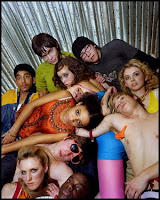 From watching the film clip of skins, we are given examples of representation of age. If we look at the 'mise en sen' used, starting with the music, there is a traditional theme tune at the begging before the clip starts, this is quite a catchy tune so if you were to hear it and were familiar with watching the show then views would know it was on.
From watching the film clip of skins, we are given examples of representation of age. If we look at the 'mise en sen' used, starting with the music, there is a traditional theme tune at the begging before the clip starts, this is quite a catchy tune so if you were to hear it and were familiar with watching the show then views would know it was on. The main character is Tony, he's the son in these episodes.
Tony is presented as a confident character; he exercises every morning and admires his appearance in the mirror. The audience would expect this from a teenage boy as teenagers are often associated with being 'full of themselves' or vain. Tony's clothing is not what the audience would expect. Clothing stereotypes for teenage boys are mainly scruffy or indecent clothes, maybe jogging bottoms. Tony, however, wears smarter, more mature clothing- a plain shirt with a v-neck jumper and trousers that do not show his underwear. Along with his tidy haircut, Tony comes appears to be quite a presentable person.
He doesn't seem to be the stereotypical teenager we appear to think of in everyday life. He cares a lot about his appearance in that he does weight training and cardiovascular exercises as soon as he gets up in the morning. He seems to like older women and comes across as confident and cocky. We also notice that he is a very organised person and everything has to be neat and tidy, maybe this is some sort of OCD, we cant tell at this stage as were only given a 5 minute clip.
The camera shots and angles used are mid shot to capture facial expressions and the surroundings a wide angle to show everything on set and the occasional close up to show tension and conflict between characters.
The dad has a very short temper and releases it through violent language. He is not aware of anything going on around him, and seems to be quite a stressed character. He's easily mugged off, and an overall lazy sloppy person with a vile personality.
The daughter in this clip seems to be quite young and quite, she obviously goes out and sneaks back in the next day through her brothers help without the family realizing She's living life as a young teenager.
The clip shows a variety of age, tony around 18/19 his sister 13/14 and the father mid 40's. We can get a sense of attitudes and different lifestyles been lived in one household.



